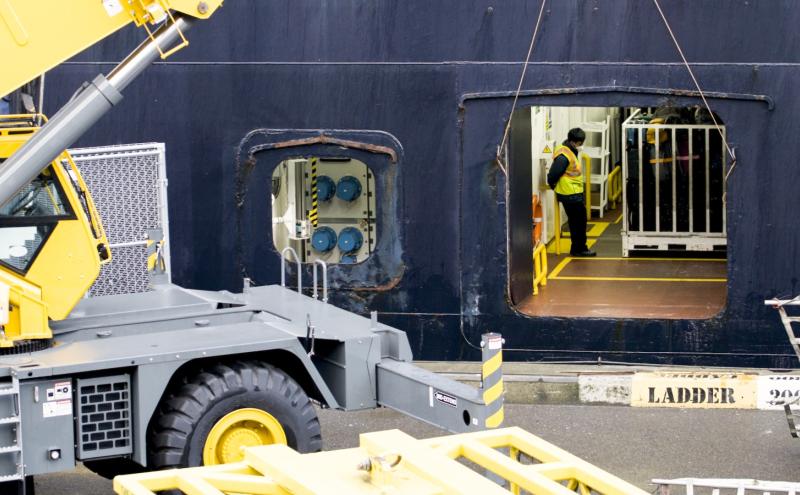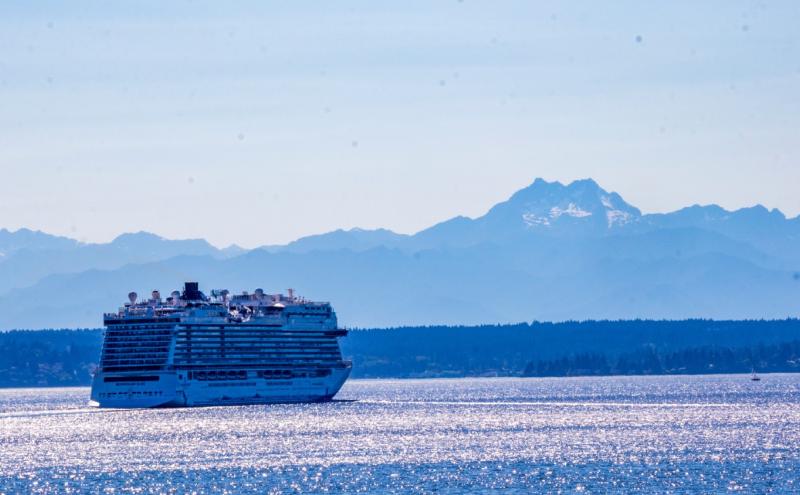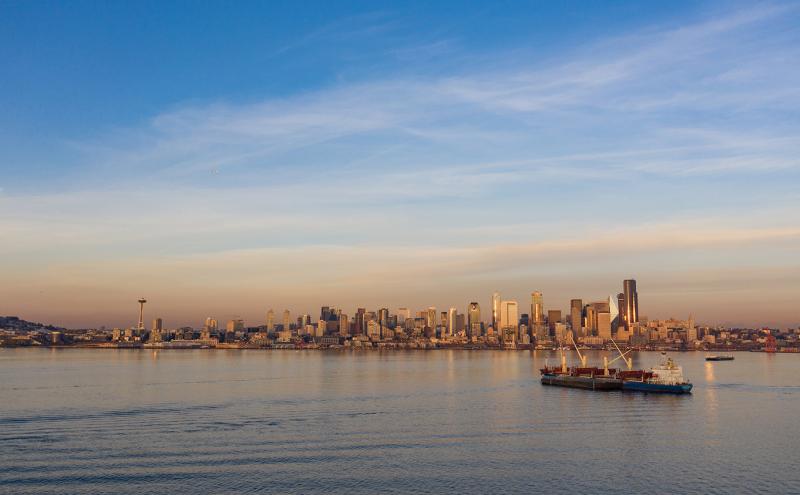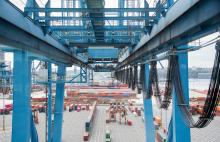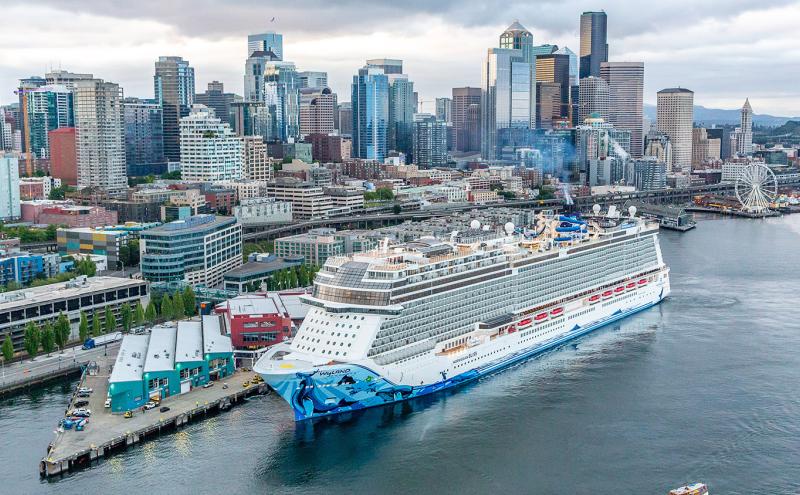
By Jack Winterhalter, Washington Sea Grant Hershman Fellow
Fuel burned by oceangoing vessels — large ships that carry marine cargo and passengers around the world — contributes about 3% of total greenhouse gas (GHG) emissions globally. Most oceangoing vessels in operation use petroleum-based fossil fuels that release greenhouse gas emissions and other air pollutants that are harmful to human health and the environment. Through the Northwest Ports Clean Air Strategy, the Port of Seattle is committed to phasing out emissions from all seaport-related activities by 2050. While improvements in engine efficiency and emission control technologies, such as at-berth solutions like shore power, can reduce emissions in the near-term, achieving our long-term goals will require a large-scale transition to next-generation maritime fuels that have the potential to achieve low and near-zero GHG emissions.
Currently there isn’t one single low and near-zero GHG emission fuel option available to the maritime industry. There are multiple potential next generation maritime fuels — ammonia and hydrogen to name a couple — at various stages of development and demonstration around the world.
- Read more about alternative maritime fuels in Maritime Alternative Fuels 101
The Pacific Northwest to Alaska Green Corridor project is assessing the feasibility of four cruise ships powered by green methanol by 2032. But what is green methanol? And what makes it a viable candidate as a next generation maritime fuel?
Methanol the molecule

Picture yourself back in high school chemistry class. You may recall learning about the periodic table of elements and the formation of molecules by bonding atoms of different elements together. Methanol is one molecule represented by the molecular formula CH3OH. When burned, it reacts with oxygen to form carbon dioxide (CO2), water (H2O), and energy in the form of heat that can be used to power an engine. Luckily, you won’t be quizzed on methanol here, but you might begin to hear about it more often as one leading next-generation fuel alternative in the maritime industry.
Compared to traditional petroleum fuels, methanol has the potential for significant benefits to local air quality, and, if produced sustainably, reductions in GHGs. However, it is not without its drawbacks.
Pros:
- Although its energy density (i.e., energy produced per unit of volume) is still not as high as petroleum-based fuels, it has the highest energy density among leading alternative fuels
- Emissions from its combustion contain significantly fewer criteria air pollutants, such as nitrogen oxides (Nox), sulfur oxides (Sox), and particulate matter
- It forms a liquid at ambient temperatures, making storage and transport easier
- It is commonly used today in the chemical industry as a precursor to a wide array of products, including adhesives, sealants, paints, and medical equipment. This existing production infrastructure can facilitate the transition to methanol fuel production
Safety concerns:
- Flammability. Methanol produces nearly invisible flames. Ships and storage facilities would need to be equipped with enhanced fire detection and prevention systems if using or storing it as a fuel
- Toxicity. While less toxic than other alternative fuels, like ammonia, direct inhalation or ingestion is still hazardous as it is metabolized by the body into toxic compounds like formaldehyde
- Corrosivity. It is corrosive to certain materials, necessitating equipment upgrades for marine engines and storage systems
Mitigating environmental and safety concerns
Like all marine fuels, proper storage and handling are necessary to prevent any accidents. Safety continues to be a top priority at the Port, so no new fuel type would be deployed without robust safety precautions in place. We work with partners at the U.S. Coast Guard, Seattle Fire Department, and the Washington Department of Ecology to better understand potential risks and best management practices. While there are certainly challenges with bringing a new fuel to our Port, methanol handling is well established globally, and the required precautions are well-understood.
While minimal, environmental impacts in the case of a methanol spill are possible. Research shows that methanol dissolves rapidly in water and is biodegraded into non-toxic substances within a few days. Acute exposure can pose a risk to marine mammals, but it is less toxic to other aquatic organisms. Overall, the environmental impacts are expected to be limited, especially when compared to petroleum fuels or ammonia. Regardless, these potential risks would be fully considered when introducing methanol as a marine fuel in our region.
What makes methanol green?
Green methanol, while chemically identical to traditional methanol, differs in its emissions profile. If they are chemically identical, wouldn’t combustion of green methanol in an engine still release carbon dioxide, just like normal methanol? It does, which is why it is especially important to look not just at combustion, but also at where this carbon came from in the first place. To make methanol a truly “net-zero” fuel (meaning its use doesn’t change the total amount of carbon in the air), the emissions that occur during combustion need to be offset during upstream production. These upstream processes include the creation, extraction, or reuse of raw materials used as inputs (also known as feedstocks), and the production and transportation of the fuel itself. Feedstocks would need to have at some point removed carbon from the atmosphere, so that combustion is not adding any new carbon to the air. Traditional methanol production also uses energy-intensive industrial processes, which need to be powered by renewable energy sources for the methanol to be truly considered “green.” Knowing these upstream details is important for determining the total climate impacts of the fuel.
Methanol fuel can be classified into different types, based on production methods and the original feedstocks. It is important to note, however, that there is a lot of variability that exists within these classifications.
The many colors of methanol
- Brown methanol ─ produced from coal and leads to high GHG emissions
- Grey methanol ─ the most common form used today, it is produced from natural gas and results in slightly higher GHG emissions than traditional marine bunker fuel
- Blue methanol ─ produced from natural gas with added technology to capture CO2, resulting in lower GHG emissions compared to grey or brown methanol
- Green methanol ─ There are two types:
- Bio-methanol: produced from biogenic resources, like municipal waste, agricultural waste, or renewable natural gas
- E-methanol: produced from green hydrogen and captured CO2
Renewable energy is used during production, resulting in net-zero emissions .
How can green corridors support the development of green methanol and other next generation maritime fuels?
Green corridors are maritime routes focused on accelerating the adoption of zero-emission fuels and technologies in shipping and cruising. They function as pilot initiatives that can help prove the efficacy of a new fuel and enable broader adoption of net-zero maritime technologies. As part of the ongoing Pacific Northwest to Alaska Green Corridor project, the Port of Seattle and partners are conducting a feasibility study on what would be required to deploy four green methanol powered cruise ships to the Alaska cruise market by 2032.
What kind of infrastructure is needed to store and fuel ships using green methanol? Where and how might this fuel be produced? How much will it cost to develop and implement this new technology? These are all questions that the feasibility study will answer. The Port and its partners aim to understand the technical, regulatory, and economic challenges that come with bringing a next generation maritime fuel like methanol to our region. The Northwest Seaport Alliance, the joint cargo operating partnership between the Ports of Seattle and Tacoma, is also working on two additional green corridors with the Republic of Korea that will assess the feasibility of green methanol for cargo ships. Alternative fuels are still more expensive than traditional fuels, so it takes early pilot projects like these, with strong partnerships between public and private entities, to drive industry forward.
The Port is working across many strategies to achieve its clean air and climate goals. Supporting the development and deployment of next generation maritime fuels like green methanol is one strategy. Similar work has been happening in aviation for many years with Sustainable Aviation Fuels. While new fuel production pathways, supporting infrastructure, and vessel technology will take time to develop, the Port recognizes the urgency and importance of this transition and the significant opportunity to position the Puget Sound region as a zero-emissions transportation hub for tourism and commerce.
Learn more about the Pacific Northwest to Alaska Green Corridor project

